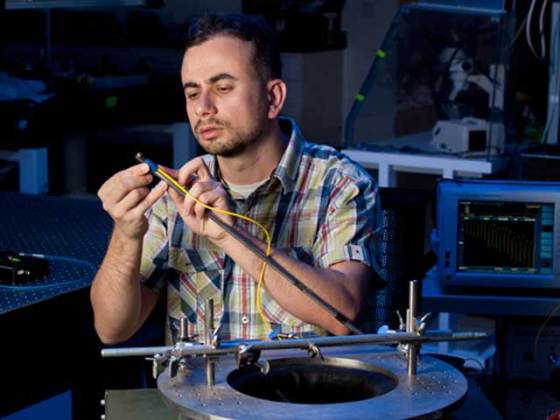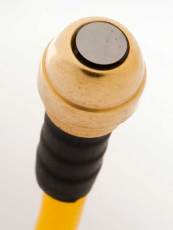Orca hearing biomimicry led to an ultrasensitive underwater microphone
 Stanford researchers have developed a highly sensitive underwater microphone which is modeled after the extraordinarily acute hearing of orcas. The microphone can capture a wide range of ocean sounds in a range of approximately 160 decibels, significantly more than existing underwater microphones (hydrophones) which have limited ranges of sensitivity and do not perform well at depth.
Stanford researchers have developed a highly sensitive underwater microphone which is modeled after the extraordinarily acute hearing of orcas. The microphone can capture a wide range of ocean sounds in a range of approximately 160 decibels, significantly more than existing underwater microphones (hydrophones) which have limited ranges of sensitivity and do not perform well at depth.
“Orcas had millions of years to optimize their sonar and it shows”, said Onur Kilic, a postdoctoral researcher in electrical engineering at Stanford University. “They can sense sounds over a tremendous range of frequencies and that was what we wanted to do.”
What orcas, humans and other creatures perceive as sound consists of small fluctuations in pressure. A microphone detects those sounds by means of a membrane or diaphragm inside it that vibrates in response to the pressure waves of sound that reach it. Unlike the fairly constant air pressure on the surface of the Earth, the water pressure in the ocean increases by the equivalent of 1 atmosphere for every 10 meters (33 feet) you descend below the surface.
The researchers fabricated a silicon chip with a thin membrane about 500 nanometers thick and drilled a grid of tiny nano-holes in it, to allow water to pass in and out. Letting water flow into the microphone keeps the water pressure on each side of the membrane equal. Although it solved the problem of pressure, having water on each side of the diaphragm lowers the amount that the diaphragm could move in response to any given sound waves that struck it.
“The kind of displacements you get of the diaphragm for the quietest sounds in the ocean is on the order of a hundred-thousandth of a nanometer”, said Kilic. “That is ten thousand times smaller than the diameter of an atom.”
The researchers ran a fiberoptic cable into the water-filled microphone, with the end of the cable positioned near the inside surface of the diaphragm, and shot light from a laser out the end of the cable onto the diaphragm. Instead of letting it pass, the holes reflect the light back toward the tip of the fiber optic cable, effectively turning the diaphragm into a mirror even as it still allowed water to pass. The intensity of the light reflected back into the cable is measured with an optical detector, and it is proportional to the deformation of the diaphragm.
In order to reach the full range of volumes they were after (a spread of 160 decibels) they used three diaphragms with a different diameter, where each diaphragm has different sensitivity to part of the range of volumes they wanted to detect. It also can detect sound frequencies across a span of 17 octaves.
Since the diaphragms are minute (the largest is three-tenths of a millimeter in diameter), the researchers could fit all three into a space far smaller than the wavelengths of the sound they sought to detect – thus allowing them to function as a single sensor. The whole housing of the microphone is barely larger than a pea.
The microphone could have a big impact on a wide range of research, from standard applications such as surveying the ocean floor to more exotic endeavors in particle physics that use acoustic detectors to monitor ultra-high-energy neutrinos plunging into the ocean.











Innovative application of Biomicking.
Dr.A.Jagadeesh Nellore(AP),India